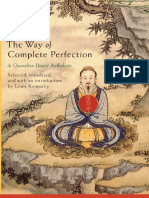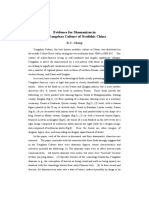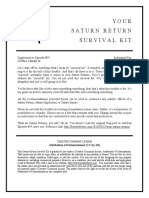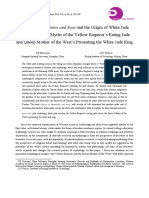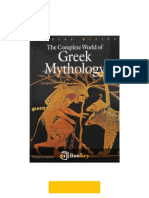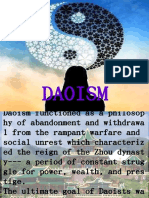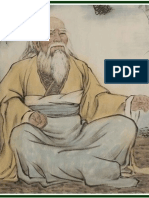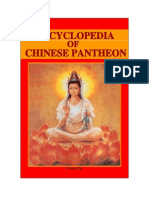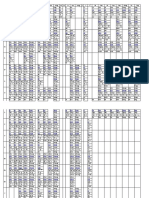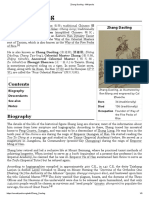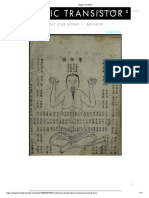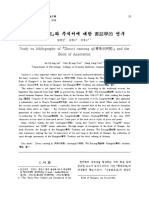0 ratings0% found this document useful (0 votes)
77 viewsThe Way of Tao
The Way of Tao
Uploaded by
Lance Joshua OdilaoThe document discusses key concepts in Taoism, including:
- Tao or Dao refers to the natural order and flow of the universe. It cannot be defined but is experienced through living in harmony with nature.
- Yin and yang represent the complementary forces in nature - yin is feminine, passive, dark while yang is masculine, active, light. Balance between these is important.
- Laozi is considered the founder of philosophical Taoism. The Tao Te Ching, attributed to him, guides Taoist thought and living in harmony with natural energies like qi.
Copyright:
© All Rights Reserved
Available Formats
Download as PPTX, PDF, TXT or read online from Scribd
The Way of Tao
The Way of Tao
Uploaded by
Lance Joshua Odilao0 ratings0% found this document useful (0 votes)
77 views12 pagesThe document discusses key concepts in Taoism, including:
- Tao or Dao refers to the natural order and flow of the universe. It cannot be defined but is experienced through living in harmony with nature.
- Yin and yang represent the complementary forces in nature - yin is feminine, passive, dark while yang is masculine, active, light. Balance between these is important.
- Laozi is considered the founder of philosophical Taoism. The Tao Te Ching, attributed to him, guides Taoist thought and living in harmony with natural energies like qi.
Original Title
THE_WAY_OF_TAO
Copyright
© © All Rights Reserved
Available Formats
PPTX, PDF, TXT or read online from Scribd
Share this document
Did you find this document useful?
Is this content inappropriate?
The document discusses key concepts in Taoism, including:
- Tao or Dao refers to the natural order and flow of the universe. It cannot be defined but is experienced through living in harmony with nature.
- Yin and yang represent the complementary forces in nature - yin is feminine, passive, dark while yang is masculine, active, light. Balance between these is important.
- Laozi is considered the founder of philosophical Taoism. The Tao Te Ching, attributed to him, guides Taoist thought and living in harmony with natural energies like qi.
Copyright:
© All Rights Reserved
Available Formats
Download as PPTX, PDF, TXT or read online from Scribd
Download as pptx, pdf, or txt
0 ratings0% found this document useful (0 votes)
77 views12 pagesThe Way of Tao
The Way of Tao
Uploaded by
Lance Joshua OdilaoThe document discusses key concepts in Taoism, including:
- Tao or Dao refers to the natural order and flow of the universe. It cannot be defined but is experienced through living in harmony with nature.
- Yin and yang represent the complementary forces in nature - yin is feminine, passive, dark while yang is masculine, active, light. Balance between these is important.
- Laozi is considered the founder of philosophical Taoism. The Tao Te Ching, attributed to him, guides Taoist thought and living in harmony with natural energies like qi.
Copyright:
© All Rights Reserved
Available Formats
Download as PPTX, PDF, TXT or read online from Scribd
Download as pptx, pdf, or txt
You are on page 1of 12
THE WAY OF TAO
WHAT IS TAO OR DAO?
TAO OR DAO
is the natural order of the universe, whose character, ones intuition
must discern to realize the potential for individual wisdom, as
conceived in the context of east Asian philosophy, east Asian
religions, or any other philosophy that aligns to this principle.
This intuitive knowing of life cannot be grasped as a concept.
Rather, It is known true actual living experience of one’s everyday
being.
It’s name, Tao or Dao came from Chinese, where it signifies the
way, path, route , road or something more loosely doctrine,
principle, or holistic belief.
Laozi in the Tao Te Ching explains that the Tao is not a name for a thing,
but the underlying natural order of the universe whose ultimate essence is
difficult to circumscribe because it is non-conceptual yet evident in one’s
being of aliveness.
The Tao is “eternally nameless”(Tao Te Ching-32 Laozi) and to be
distinguished from the countless named things that are considered to be
its manifestations, the reality of life before is descriptions of it.
Tao lends its name to the tradition(Wade-Giles, Tao Chiao; Pinyin, Dao
Jiao) and philosophical tradition(Wade-Giles, Tao Chia; Pinyin, Dao
Jia)that are both reffered to in english with the single term “Taoism”.
WAYS OF TEACHING
Taoism(also spelled Daoism) is a religion ad a philosophy from ancient
China that has influenced folk and national belief.
Taoism has been connected to the philosopher Lao Tzu, who around 500
B.C.E wrote the main, book of Taoism, the Tao Te Ching.
Taoism holds that humans and animals should live in balance with the Tao,
or the universe.
Taoists believe in spiritual immorality, where the spirit of the body joins
the universe after death.
The Tao Te Ching, or “The way and Its Power,” is a collection of poetry and sayings
from around the third and fourth centuries B.C.E that guides Taoist thought and actions.
While the author is traditionally believed to be the philosopher Lao Tzu existed at all.
Rather, the Tao Te Ching is a gathering of earlier sayings from many authors.
This book was given an origin with the philosopher Lao Tzu for cultural and political
reasons.
Lao Tzu is sometimes understood as the image of the Tao, or a god, and given legendary
status.
The Tao(or Dao) is hard to define but is sometimes understood as the way of the
universe.
Taoism teaches that all living creatures ought to live in a state of harmony with the
universe, and the energy found in it. Ch’i, or qi, is the energy present in and guiding
everything in the universe.
The Tao Te Ching and other Taoist books provide guides for behavior and spiritual ways of living
in harmony with this energy. However, Taoists do not believe in this energy as a god. Rather,
there are gods as part Taoist beliefs, often introduced from the various cultures found in the
region known now as china. These gods are part of the Tao, like all living things.
Taoism has temples, monasteries, and priests who make offering, meditate, and perform other
rituals for their communities.
Taoism became well-known in the eighth century C.E. as the religion of the tang dynasty. In the
following centuries, it existed alongside Buddhism and Confucianism (another philosophical
religion ).however ,during the communist take over in 1959,Taoism, Confucianism, and other
religions were banned.
This caused a decline in the practice of Taoism in china. Many modern Taoists line in Taiwan,
although recent reforms in china have increased the number of Chinese Taoists.
One of the main ideas of Taoism is the belief in balancing forces, or Yin and Yang. These ideas
represent matching pairs, such as light and dark, hot and cold, action and inaction, which work
together toward a universal whole. Yin and Yang show that everything in the universe is
connected and that nothing makes by itself.
Laozi(Lao-tzu)
○ is the name of a legendary Daoist philosopher, the
alternate title of the early Chinese text better known
in the West as the Daodejing, and the moniker of a
deity in the pantheon of organized “religious
Daoism” that arose during the later Han dynasty (25-
220 C.E.).
○ Laozi is the pinyin romanization for the Chinese
characters which mean “Old Master.” Laozi is also
known as Lao Dan (“Old Dan”) in early Chinese
sources (see Romanization systems for Chinese
terms).
○The Zhuangzi (late 4th century B.C.E.) is the first
text to use Laozi as a personal name and to identify
Laozi and Lao Dan.
YIN AND YANG
Yin, Chinese for “female” or “moon”, represents darkness, femininity,
passivity, and the earth. Yang “ sun” or “male” represents light,
masculinity, activity, and the heavens.
The balance of yin and yang were seen to influence health and order
within and individual, society, and the entire universe.
The yin and yang symbol represents the interconnectedness of the world,
particularly the natural world. There be no positive without a negative, no
open without closed, no light without shadow. The yin and yang itself
portrays that interrelatedness.
YANG YIN
MALE FEMALE
LIGHT DARK
DAY NIGHT
HOT COLD
STRONG WEAK
ADVANCING RETREATING
SUMMER WINTER
ACTIVE PASSIVE
AWAKE ASLEEP
LOUD QUIET
SUN MOON
ACTIVITY REST
GOOD BAD
FAST SLOW
SKY ABOVE OR HEAVEN GROUND BELOW OR EARTH
IN SOCIETY THE EMPEROR LOYAL SUBJECTS
HEAD LEGS
EXPANDING CONTRACTING
MOVEMENT STILLNESS
DOMINATING CREATIVE
THE KNOWN THE UNKNOWN
ACTIVE CALM
CLEAN DIRTY
SMOOTH ROUGH
LARGE SMALL
BOLD SUBTLE
MASCULINE FEMININE
STRAIGHT CURVY
Click icon to add picture
You might also like
- Origami Yin-YangDocument2 pagesOrigami Yin-YangMaja PasarićNo ratings yet
- The Hundred Words Stele by Lu Dongbin 4 Commentary by Zhang SanfengDocument2 pagesThe Hundred Words Stele by Lu Dongbin 4 Commentary by Zhang SanfengaaNo ratings yet
- The Way of Complete Perfection - A Quanzhen Daoist Anthology (PDFDrive)Document470 pagesThe Way of Complete Perfection - A Quanzhen Daoist Anthology (PDFDrive)Andre MontegomeriNo ratings yet
- Qigong Movements For Legs and FeetDocument6 pagesQigong Movements For Legs and FeetJojo La0% (1)
- Eight Great Spiritual MantrasDocument7 pagesEight Great Spiritual MantrasLye Chien Chai100% (1)
- Macrocosm Mesocosm and MicrocosmDocument37 pagesMacrocosm Mesocosm and MicrocosmArunNo ratings yet
- Kulpuja - A Ritual and Behaviour of MagarDocument6 pagesKulpuja - A Ritual and Behaviour of MagarBina AdhikariNo ratings yet
- Mystery and Secrecy in The Contact of Da PDFDocument39 pagesMystery and Secrecy in The Contact of Da PDFJason FranklinNo ratings yet
- Tales of The Eight ImmortalsDocument8 pagesTales of The Eight ImmortalsPriya SeshadriNo ratings yet
- Chapter Twenty-Seven - The Pañcatattva (The Secret Ritual)Document25 pagesChapter Twenty-Seven - The Pañcatattva (The Secret Ritual)Kannan VenkataramanNo ratings yet
- Reproduction and Aggression: Shamanic Practices Among Quichuas From Ecuador (Imbabura and Chimborazo Provinces)Document24 pagesReproduction and Aggression: Shamanic Practices Among Quichuas From Ecuador (Imbabura and Chimborazo Provinces)Anna PrzytomskaNo ratings yet
- Significance of Havan (Homam) in Hinduism - Ganges India'sDocument2 pagesSignificance of Havan (Homam) in Hinduism - Ganges India'samnotaname4522100% (1)
- A Chaosphere UnbindingDocument3 pagesA Chaosphere UnbindingPooheadNo ratings yet
- Magic SEA Underground Magic SEA Underground: Curing Spirit Possession DIY (自助 驱 邪法)Document19 pagesMagic SEA Underground Magic SEA Underground: Curing Spirit Possession DIY (自助 驱 邪法)tractorbeamingNo ratings yet
- Burchard S I Strigae I The Witches SabbaDocument32 pagesBurchard S I Strigae I The Witches SabbaAline SantosNo ratings yet
- Avatamsaka: Matrix On Entering The Dharma Realm ChapterDocument8 pagesAvatamsaka: Matrix On Entering The Dharma Realm ChapterGuo CheenNo ratings yet
- Taosim AS2Document9 pagesTaosim AS2Ned TinneNo ratings yet
- Healing and Spirituality in Tanzania:: The Mganga Figure Between Literature, Myths and BeliefsDocument23 pagesHealing and Spirituality in Tanzania:: The Mganga Figure Between Literature, Myths and BeliefsTitus kiprotich kenduuwoNo ratings yet
- Samoyedic Shamanic Drums Some Symbolic InterpretationDocument22 pagesSamoyedic Shamanic Drums Some Symbolic InterpretationGerard Canals PuigvendrelloNo ratings yet
- Chinese ProverbsDocument9 pagesChinese ProverbsRodney OhebsionNo ratings yet
- Blood, Tigers, Dragons: TH e Physiology of Transcendence For WomenDocument40 pagesBlood, Tigers, Dragons: TH e Physiology of Transcendence For WomenAnonymous GQ7ANnsDXNo ratings yet
- Confucianism (Document10 pagesConfucianism (sldsjdNo ratings yet
- White Tara SadhanaDocument4 pagesWhite Tara SadhanaVoid ReaPNo ratings yet
- Magic SEA Underground Magic SEA Underground: Taoist 7 Steps Exorcism Method (七步 驱鬼法)Document15 pagesMagic SEA Underground Magic SEA Underground: Taoist 7 Steps Exorcism Method (七步 驱鬼法)tractorbeamingNo ratings yet
- Eight Great Spirit ChantsDocument22 pagesEight Great Spirit ChantsRaul Correa FilhoNo ratings yet
- Higher Powers of Mind and Spirit PDFDocument99 pagesHigher Powers of Mind and Spirit PDFavisenicNo ratings yet
- Majiayao Legacy A Neolithic Record of AsDocument70 pagesMajiayao Legacy A Neolithic Record of AsZulfiyya Nuraliyeva100% (1)
- Galdr or GaldorDocument17 pagesGaldr or GaldorTimotheeNo ratings yet
- Shamanism in YangshaoDocument2 pagesShamanism in YangshaoCentre Wudang Taichi-qigongNo ratings yet
- Wu, Y. (1996) - Outlaws' Dreams of Power and Position in Shuihu ZhuanDocument24 pagesWu, Y. (1996) - Outlaws' Dreams of Power and Position in Shuihu ZhuanJamie StockdaleNo ratings yet
- Your Saturn Return Survival Kit Benebell Wen1Document13 pagesYour Saturn Return Survival Kit Benebell Wen1rgtreads0% (1)
- Chinese Symbols-AnimalsDocument5 pagesChinese Symbols-AnimalsBlueBlue4No ratings yet
- The Nature of The Occult Within The ZhuaDocument18 pagesThe Nature of The Occult Within The ZhuaZornia FangornNo ratings yet
- Demonic Warfare - Daoism, Territorial Networks, and The History of A Ming NovelDocument290 pagesDemonic Warfare - Daoism, Territorial Networks, and The History of A Ming NovelRhea Sunshine100% (1)
- Ganesha The Elephant Headed God The God of WisdomDocument27 pagesGanesha The Elephant Headed God The God of WisdomTomas Israel RodriguezNo ratings yet
- Nine Principles of Wiccan FaithDocument2 pagesNine Principles of Wiccan FaithAndy AfrikkaNo ratings yet
- Adeptas Femininas TaoismosDocument15 pagesAdeptas Femininas TaoismosÉdison Nogueira da FontouraNo ratings yet
- On The Myths of The Yellow Emperor's Eating Jade and Queen Mother of The West's Presenting The White Jade RingDocument18 pagesOn The Myths of The Yellow Emperor's Eating Jade and Queen Mother of The West's Presenting The White Jade RingNadge Frank AugustinNo ratings yet
- Book of The Forest PathDocument52 pagesBook of The Forest Pathevangineermc100% (1)
- Kate Trantric 14639940008573729Document60 pagesKate Trantric 14639940008573729noona0728301No ratings yet
- HS12Shuikung pdf1Document33 pagesHS12Shuikung pdf1kakaroto_roshi100% (1)
- Daoist Ritual, State Religion, and Popular Practices: Zhenwu Worship From Song To Ming (960-1644) by Shin-Yi Chao (Review)Document5 pagesDaoist Ritual, State Religion, and Popular Practices: Zhenwu Worship From Song To Ming (960-1644) by Shin-Yi Chao (Review)brentcochranNo ratings yet
- Samhain Full Moon Ritual - Scorpio: Friday 1st May 2015Document6 pagesSamhain Full Moon Ritual - Scorpio: Friday 1st May 2015StrangeLittleBoyNo ratings yet
- The Complete World of Greek MythologyDocument16 pagesThe Complete World of Greek MythologyLindokuhleNo ratings yet
- History of The Thule Society - Edición 2020-252-442Document241 pagesHistory of The Thule Society - Edición 2020-252-442hyperboreanpublishing100% (1)
- Magic SEA Underground Magic SEA Underground: Who Is Knocking At 3am Annually? (凶煞回魂)Document15 pagesMagic SEA Underground Magic SEA Underground: Who Is Knocking At 3am Annually? (凶煞回魂)tractorbeaming0% (1)
- Representations of Padmasambhava in Earl PDFDocument46 pagesRepresentations of Padmasambhava in Earl PDFJohannesNo ratings yet
- VedasDocument3 pagesVedasAllen CruzNo ratings yet
- Mapping The Body: Space, Time and Gender: Catherine Despeux - 9789004366183 Via Free AccessDocument18 pagesMapping The Body: Space, Time and Gender: Catherine Despeux - 9789004366183 Via Free AccesscarmelaNo ratings yet
- Ekran Resmi 2023-10-12 - 16.12.32Document148 pagesEkran Resmi 2023-10-12 - 16.12.32Daniel DimitrescuNo ratings yet
- Korean Shamanism TodayDocument12 pagesKorean Shamanism TodaymcamerovalladaresNo ratings yet
- Indie Shaman - Issue 45Document48 pagesIndie Shaman - Issue 45ArcanistNo ratings yet
- The Secret of The Golden Flower 2 Research On The TextDocument2 pagesThe Secret of The Golden Flower 2 Research On The TextaaNo ratings yet
- Taoism and Celts HSC Preliminary Stage 6 SyllabusDocument31 pagesTaoism and Celts HSC Preliminary Stage 6 Syllabusapi-332002291100% (1)
- Developing Clarity and StillnessDocument5 pagesDeveloping Clarity and StillnessRaul Correa FilhoNo ratings yet
- Goddess KaliDocument3 pagesGoddess KaliPredator 1No ratings yet
- Yin and Yang in Heart of DarknessDocument5 pagesYin and Yang in Heart of Darknessccwettr123No ratings yet
- W.I.T.C.H ScriptDocument8 pagesW.I.T.C.H ScriptemilyallennNo ratings yet
- طقوس عامDocument598 pagesطقوس عامAtheer AhmadNo ratings yet
- Animal SymbolismDocument1 pageAnimal SymbolismHugh Fox IIINo ratings yet
- Dharani and Spells in Medieval Sinitic BuddhismDocument30 pagesDharani and Spells in Medieval Sinitic BuddhismwhodatninjaNo ratings yet
- From 001 to 100: One Hundred Poems Completed by Alexander GoldsteinFrom EverandFrom 001 to 100: One Hundred Poems Completed by Alexander GoldsteinNo ratings yet
- Ceu Religion 11: TaoismDocument33 pagesCeu Religion 11: TaoismCel AyunayunNo ratings yet
- Taoism ReportsDocument43 pagesTaoism ReportsCherry May BernardoNo ratings yet
- Piano ScoreDocument3 pagesPiano ScoreqazdwjsifhakdhfuewNo ratings yet
- Lao Tzu Prayer TaoismDocument1 pageLao Tzu Prayer TaoismlifestylesNo ratings yet
- ScriptDocument3 pagesScriptHemantVermaNo ratings yet
- DaoismDocument26 pagesDaoismMay RodeoNo ratings yet
- Chronoacupuncture - Ling Gui Ba Fa - 60 Day CycleDocument1 pageChronoacupuncture - Ling Gui Ba Fa - 60 Day CycleChachy999No ratings yet
- Introduction Note-Day MasterDocument5 pagesIntroduction Note-Day MasterLiew Chee Kiong0% (2)
- Iwrbs 2nd Quarter Module 6Document9 pagesIwrbs 2nd Quarter Module 6jetirish saballaNo ratings yet
- Dao Yin (導引) Training: 1. Postural Dao Yin 2. Respiratory Dao Yin Mental Dao YinDocument1 pageDao Yin (導引) Training: 1. Postural Dao Yin 2. Respiratory Dao Yin Mental Dao YinWan Sek ChoonNo ratings yet
- DAOISMDocument27 pagesDAOISMRaisah Kamilah DaytoNo ratings yet
- Neidan NotesDocument27 pagesNeidan Notesnaran solankiNo ratings yet
- TAOISM Group 6 PresentationDocument16 pagesTAOISM Group 6 PresentationAirod Lance TurcoNo ratings yet
- Lsec3 Lesson14 BDocument7 pagesLsec3 Lesson14 BCavebear 2020No ratings yet
- Roaming Free Inside The Cage - The Daoist Principle of Nonaction Reexamined - AbridgedDocument20 pagesRoaming Free Inside The Cage - The Daoist Principle of Nonaction Reexamined - AbridgedJesse Brenner100% (1)
- Encyclopedia of Chinese PantheonDocument200 pagesEncyclopedia of Chinese PantheonKula100% (14)
- Nei Jing Tu A Daoist Diagram of The Internal Circulation of Man 1992 PDFDocument19 pagesNei Jing Tu A Daoist Diagram of The Internal Circulation of Man 1992 PDFJim Weaver100% (1)
- What Are The 8 TrigramsDocument4 pagesWhat Are The 8 TrigramsJonathan BluesteinNo ratings yet
- The Dao That Is Tai Chi Chuan: Traditional Martial Arts AssociationDocument3 pagesThe Dao That Is Tai Chi Chuan: Traditional Martial Arts AssociationNicolas DrlNo ratings yet
- Wudang Taiji36 Translation PDFDocument2 pagesWudang Taiji36 Translation PDFRodney S BhallyNo ratings yet
- Combinaciones Iniciale Sy FinalesDocument6 pagesCombinaciones Iniciale Sy FinalesAny PerezNo ratings yet
- Zhang DaolingDocument3 pagesZhang DaolingRoberto NeedhamNo ratings yet
- Taoism 1Document17 pagesTaoism 1Cris Licsi MantesNo ratings yet
- Magic TransistorDocument11 pagesMagic TransistorTrần Danh VũNo ratings yet
- Four Pillars of Destiny - BaziDocument3 pagesFour Pillars of Destiny - BaziSuraj100% (1)
- 주역참동계 (周易參同契) 와 주석서에 대한 서지학적 (書誌學的) 연구Document9 pages주역참동계 (周易參同契) 와 주석서에 대한 서지학적 (書誌學的) 연구pleasantsongNo ratings yet
- Ganzhi 8 - 3 - 17Document2 pagesGanzhi 8 - 3 - 17rendaoNo ratings yet


